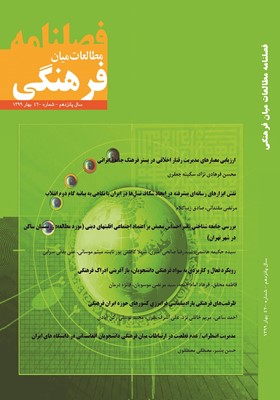مدیریت اضطراب/ عدم قطعیت در ارتباطات میان فرهنگی دانشجویان افغانستانی در دانشگاه های ایران
محورهای موضوعی : مطالعات میان فرهنگی
1 - استاد گروه فرهنگ و ارتباطات، دانشکدۀ معارف اسلامی ، فرهنگ و ارتباطات، دانشگاه امامصادق
2 - دانشجوی دکتری، جامعه شناسی فرهنگی، واحد علوم تحقیقات ، دانشگاه آزاد اسلامی، تهران ، ایران
کلید واژه: ایرانیان, عدم قطعیت, ارتباطات میان فرهنگی, مهاجرین افغانستانی, مدیریت اضطراب,
چکیده مقاله :
همزیستی افغانی ها با ایرانیان تاریخ طولانی دارد. همسایگی دو کشور از نظر جغرافیایی، قرابت فرهنگی و اشتراکات فرهنگی موجب شده آنها در دهه های اخیر بیشتر ارتباط داشته باشند. زبان، دین، اشتراکات فرهنگی زمینه امکاناتی نظیر تحصیلات در مراتب بالا را برای آنها فراهم نموده است. اما ارتباطات میان ایرانی ها و افغانی ها به رغم اشتراکات، از اختلافات فرهنگی برخوردار است. بر اساس نظریه مدیریت اضطراب/عدمقطعیت گادیکانست و انطباق میان فرهنگی غریبه ها به عنوان رویکرد جدید ارتباطات میان فرهنگی با هدف تعامل ما با غریبه (دیگری)؛ و حفظ و نگهداشت آن در سطح مطلوب - جایی میان آستانه حداکثر و حداقل- بهمنظور برقراری ارتباط مؤثر با دیگری در نظر گرفته شده است. روش تحقیق از نوع کیفی انتخاب و با 15 نفر از دانشجویان مهاجر افغانی مقیم تهران صورت پذیرفت و تحلیل رفتارهای آنها مطابق با نظریه گادیکانست مورد تحلیل قرار گرفت. نتایج تحقیق نشان داد دانشجویان افغانستانی در ایران احساس مثبت و خوبی دارند و از نظر ارتباطات فرهنگی در محیط دانشگاهی مشکلات کمتری با ایرانی ها دارند، آنها تبعیض کمتری نسبت به خود احساس می کنند و معتقدند با بالارفتن سطح آگاهیشان؛ مدیریت اضطراب در مواجهه با ایرانی ها تقویت شده و با قطعیت بیشتری از جامعه میزبان به پیش بینی می پردازند. افزایش آگاهی، آموزش، برنامه های رسانه ای می تواند در جهت افزایش همکاری و همدلی میان ایرانیان و افغانی ها در سطح وسیع و کاستن سطح اختلاف میان ایشان ارائه گردد.
The coexistence of Afghans with Iranians has a long history. The two countries' neighborhood in terms of geography, cultural affinity and cultural commonalities has led to more communication in recent decades. Language, religion, and cultural commonalities have provided them with opportunities such as higher education. But relations between Iranians and Afghans, despite their commonalities, also have cultural differences. Based on the theory of "anxiety management / Gudykunst uncertainty and cross-cultural adaptation of strangers" as a new approach to intercultural communication with the aim of our interaction with the stranger (another); And its maintenance at the desired level - somewhere between the maximum and minimum thresholds - is considered to establish an "effective connection" with the "other". The research method is qualitative and was conducted with 15 Afghan immigrant students living in Tehran and their behaviors were analyzed according to Gudykunst theory. The results showed that Afghan students in Iran have positive and good feeling and have less problems with Iranians in terms of cultural communication in the university environment, they feel less discrimination against themselves and believe that as their level of awareness increases; Anxiety management in dealing with Iranians is strengthened and they predict with more certainty about the host community. Raising awareness, education, media programs can be offered to increase cooperation and empathy between Iranians and Afghans on a large scale and reduce the level of differences between them.
بشیر، حسن و بذرافشان، محمدرضا (1399). « مدیریت اضطراب/ عدم قطعیت در ارتباطات میان فرهنگی با اهل سنت، مطالعه روایی».راهبرد اجتماعی فرهنگی، پاییز 1399 ، شماره 3.
بشیر، حسن؛ کشانی، محمد جواد( 1398). « ارتباطات میان فرهنگی افغان های مقیم ایران با ایرانیان بر پایه نظریه هم فرهنگی»،فصلنامه علمی مطالعات میان فرهنگی، 14(41)، 9-30.
دنزباخ، ولفگانگ ( 1390 ).دانشنامه بین الملیلی ارتباطات.(ویراستاران: حسن بشیر و مسعود کوثری). تهران: دانشگاه امام صادق علیه السلام.
زرقانی، هادی و موسوی، زهرا( 1392 ). مهاجرت های بین المللی و امنیت ملی. فصلنامه مطالعات راهبردی. 16 (59)، شماره پیاپی 59 . صفحات 26-7 .
سامووار، ل. ا؛ پورتز، ریچارد و استفانی، لیزا ( 1379 ). ارتباط بین فرهنگ ها، ترجمه غلامرضا کیانی و سید اکبر میر حسینی، تهرن: انتشارات باز.
صادقی فسایی، سهیلا؛ نظری، حامد( 1395 ). بچه افغانی: شکل گیری تصور از خود و دیگری در تجربه زندگی روزمره نوجوانان افغان، مطالعات و تحقیقات اجتماعی در ایران، 5(3)، (پیاپی 19 )، صفحات 456 - 437.
عابدی جعفری، حسین و همکاران ( 1390 ). تحلیل مضمون و شبکه مضامین: روشی ساده و کارآمد برای تبیین الگوهای موجود در داده های کیفی، اندیشه مدیریت راهبردی (اندیشه مدیریت)، 5(2). صفحات 198 -151.
گادیکانست، ویلیام بی ( 1396 ). نظریه پردازی درباره ارتباطات میان فرهنگی، ترجمه حسن بشیر و همکاران، چاپ اول، تهران : انتشارات دانشگاه امام صادق (ع).
Braun, V. & Clarke, V. (2006). Using Thematic Analysis in Psychology, Qualitative Research in Psychology, 3 (2), 77-101
. Giles, H., Watson, B. (2008). The International Encyclopedia of Communication, USA: Blackwell Publishing
Gudykunst, W. (1993). Toward a theory of effective interpersonal and intergroup communication: an anxiety/ ncertainly management (AUM) perspective.
Gudykunst, W.B. (1995). Anxiety/uncertainty Management (AUM) Theory. In R.L. Wiseman (Ed.), Intercultural Communication Theory (pp.8-58). Thousand Oaks, CA: Sage.
Gudykunst, W. B. (1998a). Applying Anxiety/uncertainty Management (AUM) Theory to Intercultural Adjustment Training, International Journal of Intercultural Relations, 22, 227-250.
Hammer, M. R.; Wiseman, R.L.; Rasmussen, J., & Bruschke, J. (1998). A Test of Uncertainty/anxiety Reduction Theory: The Intercultural Adaptation Context. Communication Quarterly, 46, 309-326.
Marris, P. (2003). The Politics of Uncertainty: Attachment in Private and Public life, UK: Routledge
Oetzel, J. (2017). Effective Intercultural Workgroup Communication Theory. The International Encyclopedia of Intercultural Communication. 1-5.
Reynolds, P. (1971). A Primer in Theory Construction, Indianapolis, IN: Bobbs-Merrill
Stephan,W. & Stephan, C. (1985). Intergroup Anxiety, Journal of Social Issues, 41(3), 157-175
Williams, Rob. (2016). “Syrian refugees will cost ten times more to care for in Europe than in neighboring countries, Independent, available at: www.independent.co.uk
Ulmer, R.; Sellnow, T. & Seeger, M. (2012). Effective Crisis Communication, Moving from Crisis to Opportunity, (M. Ghilich & M. Khatibi Bayegi, Trans.) Tehran: Imam Sadiq University (AS). (in Persian)
_||_

